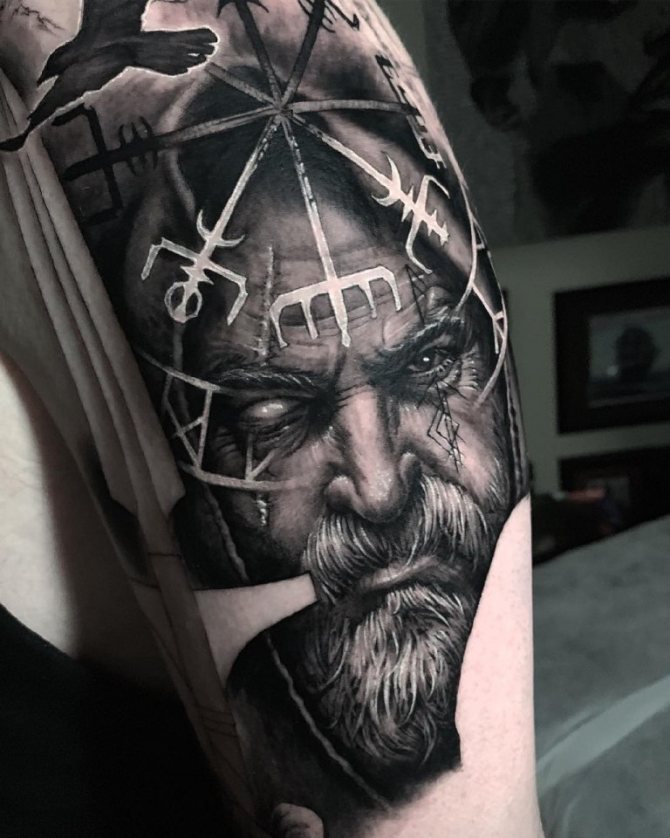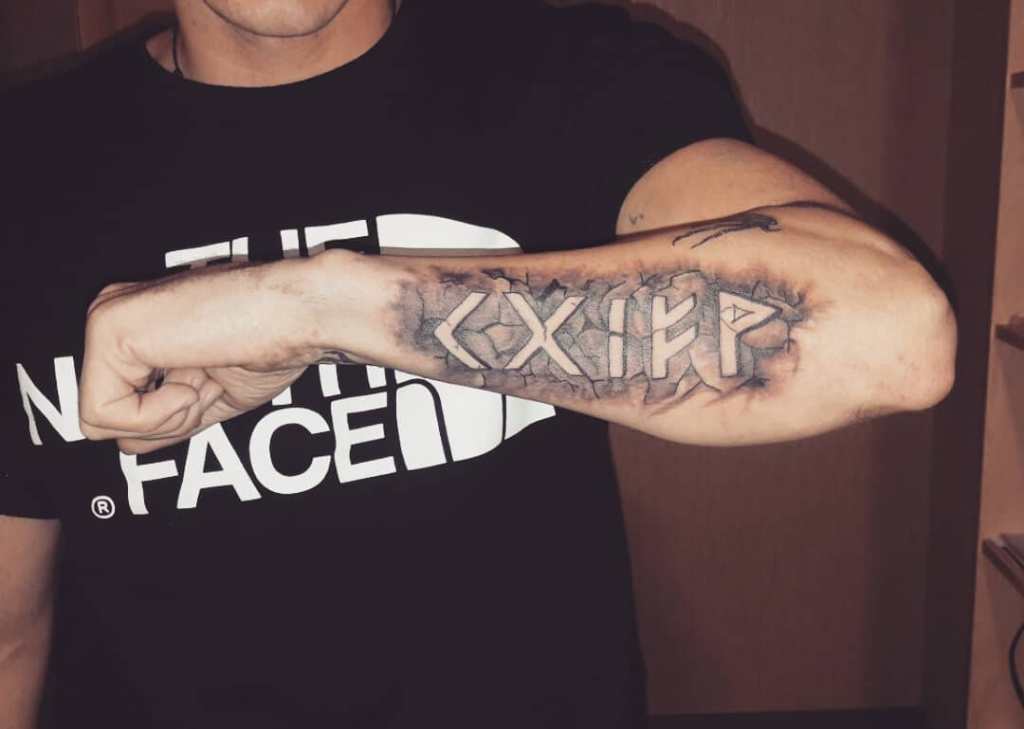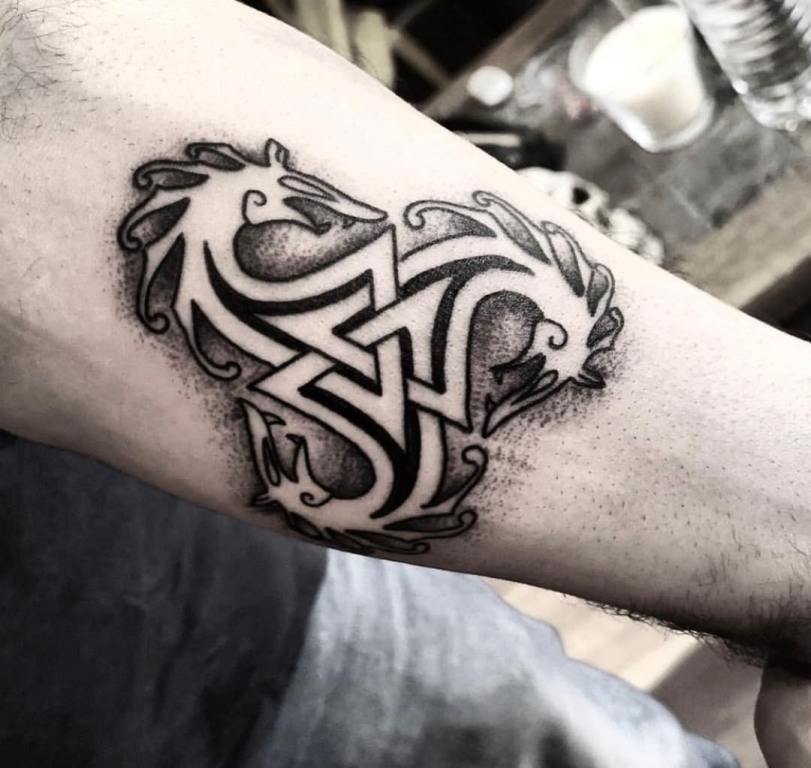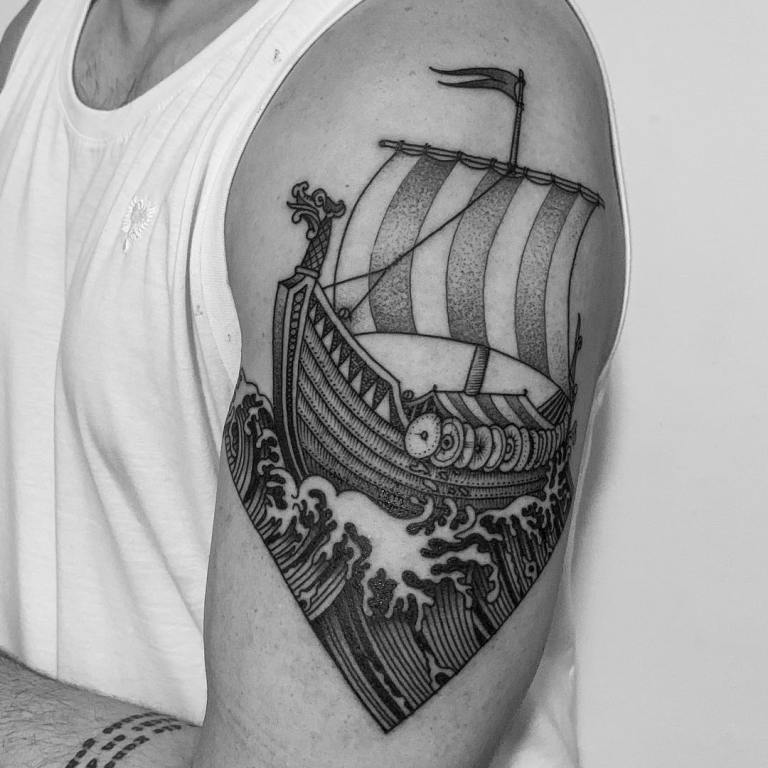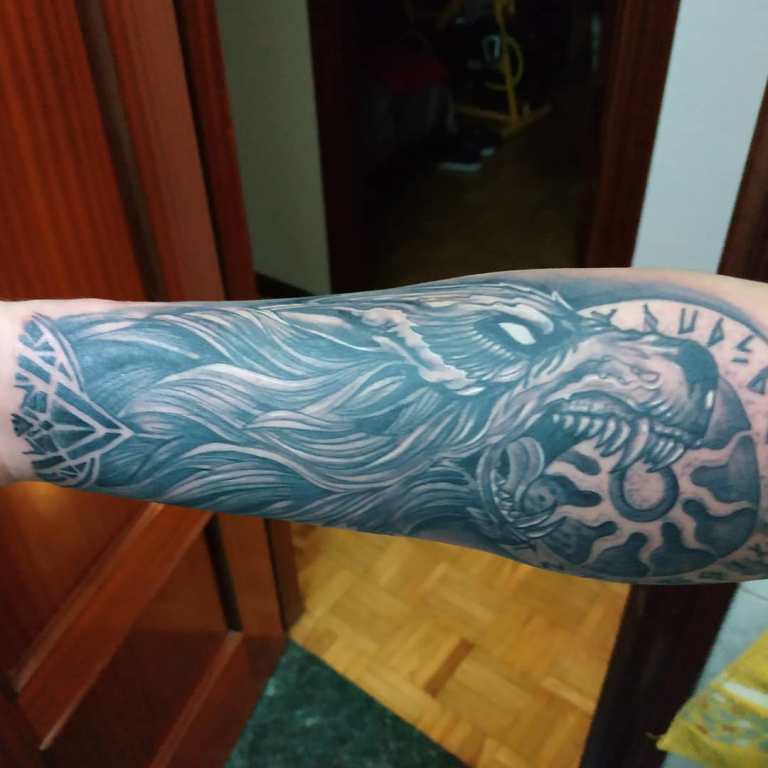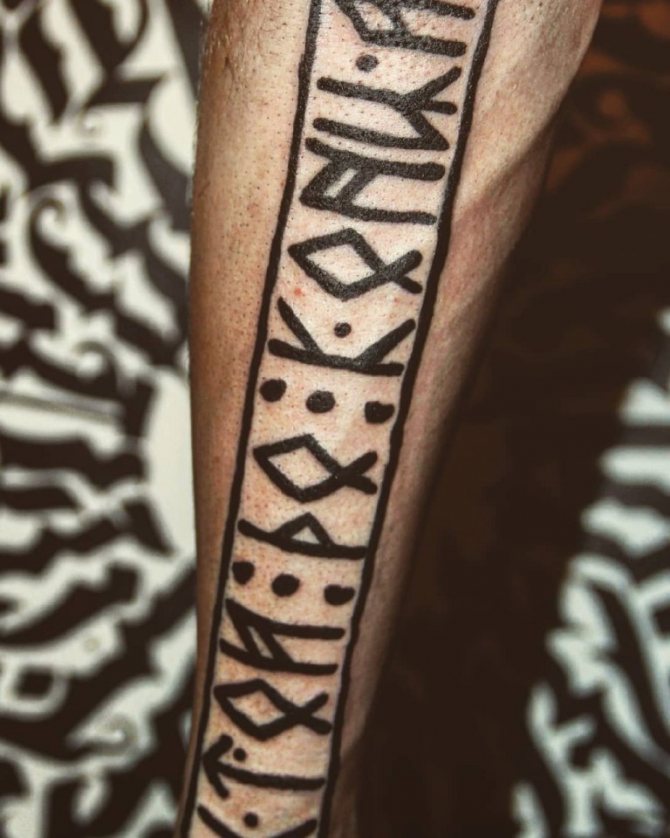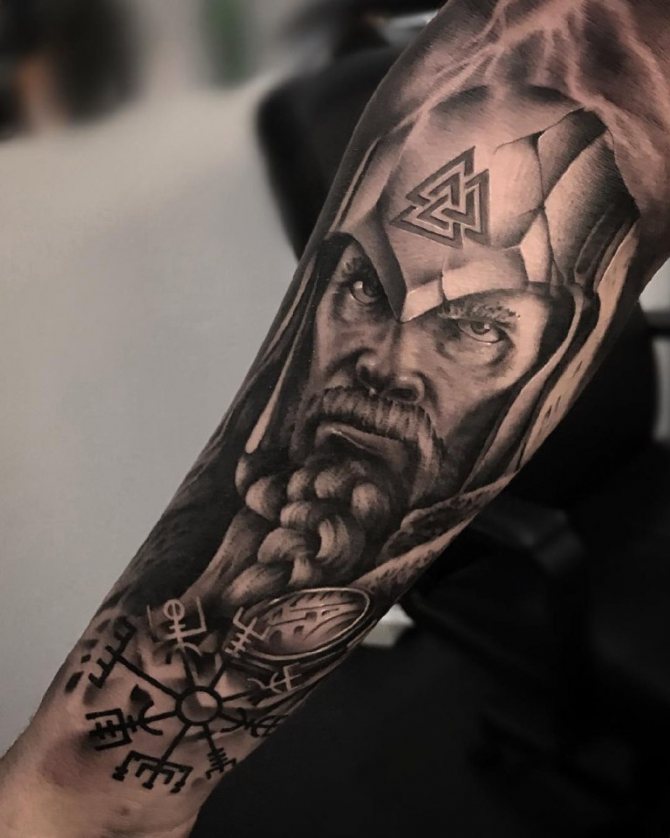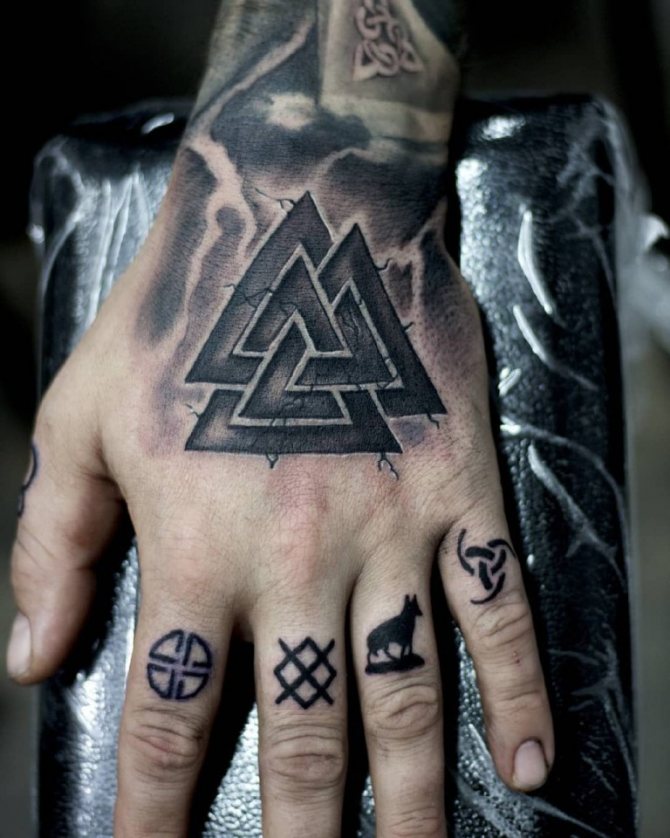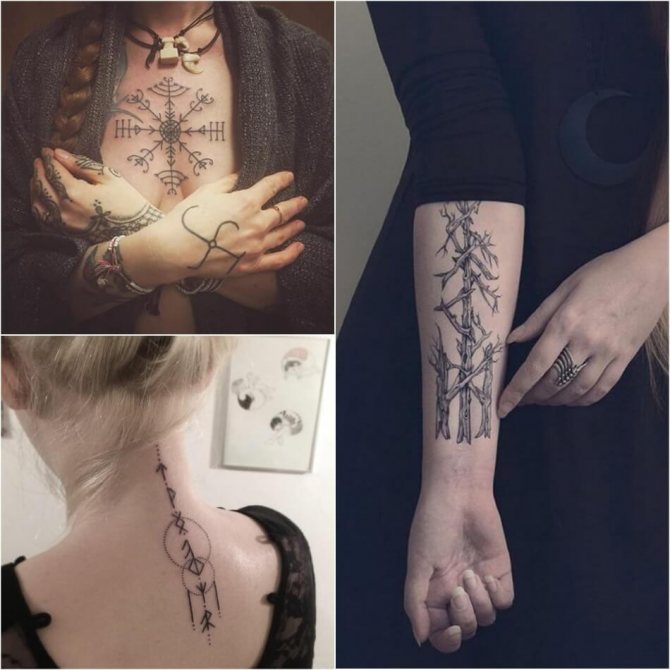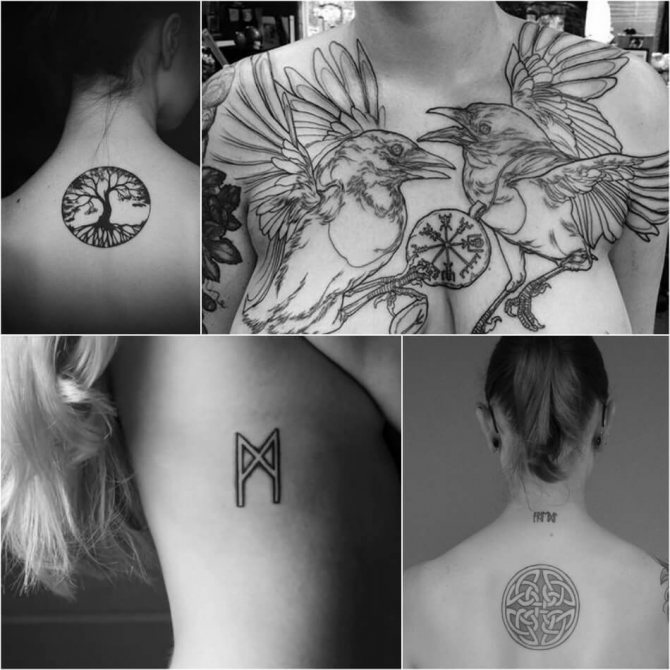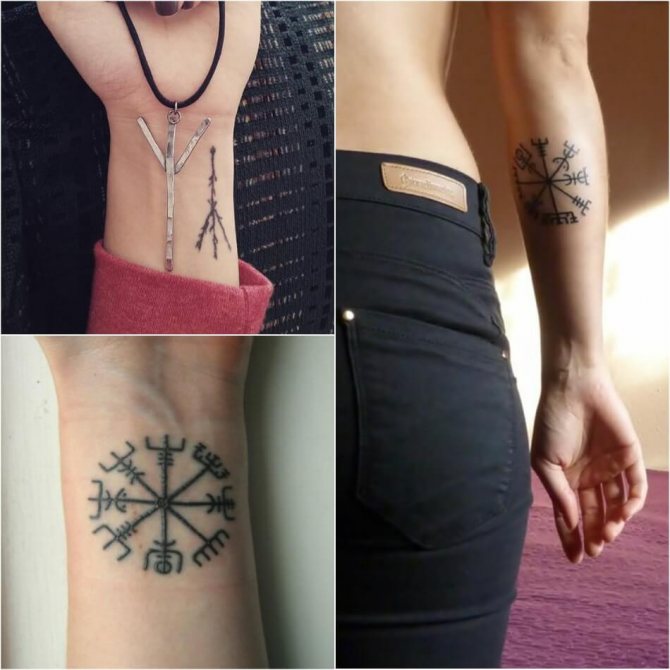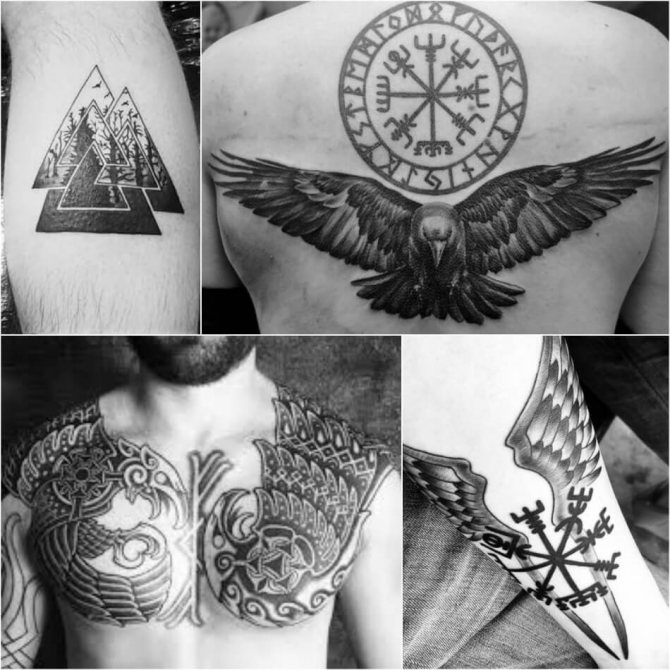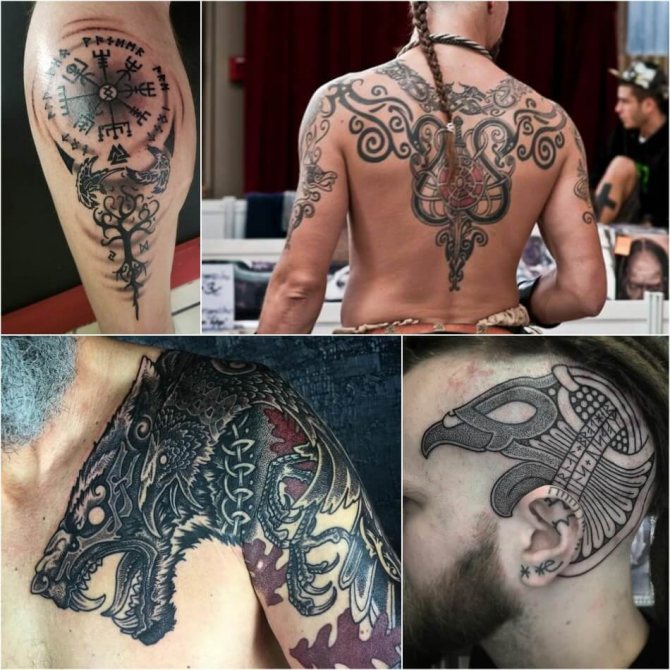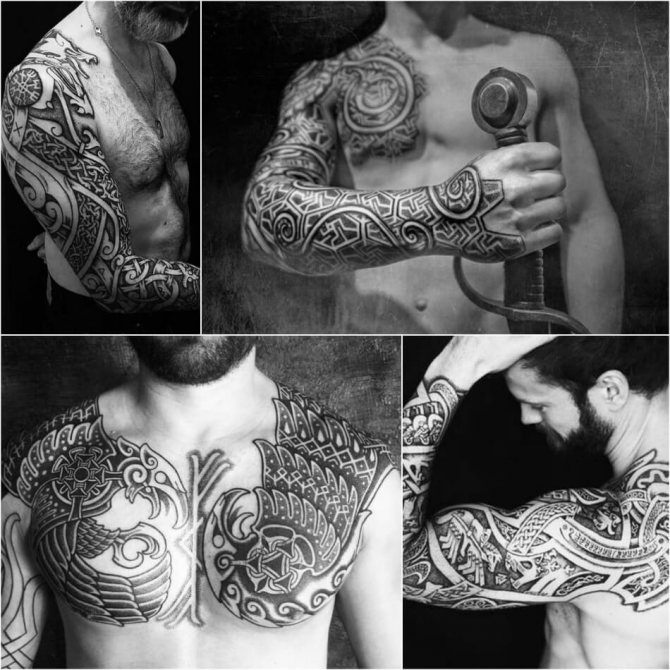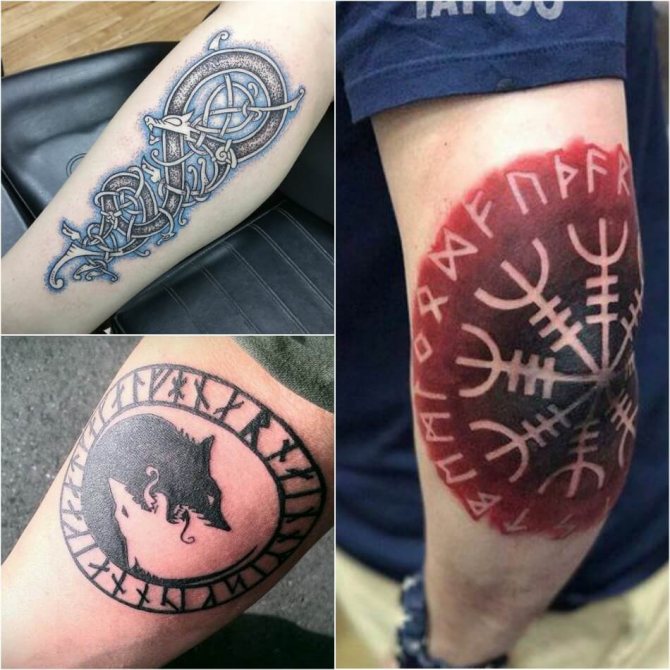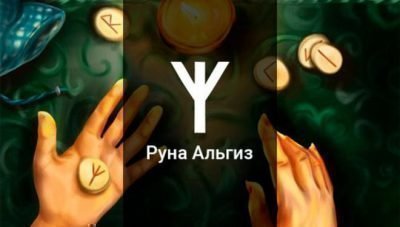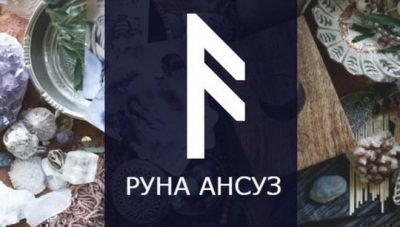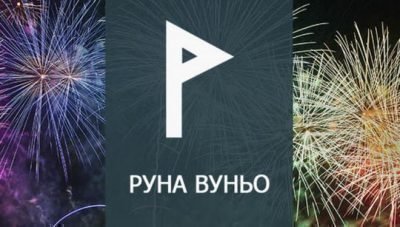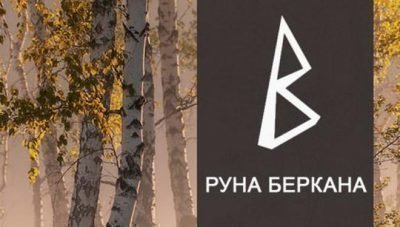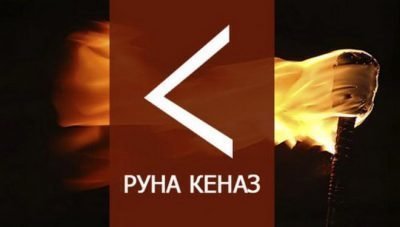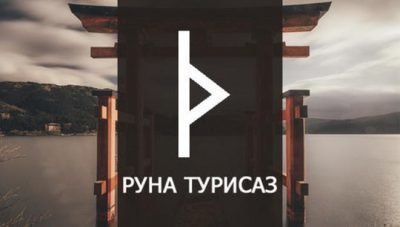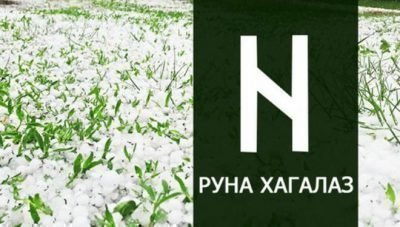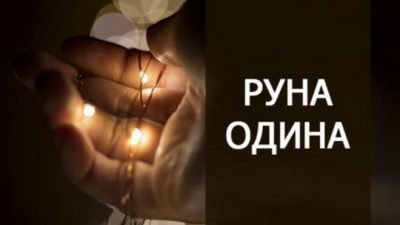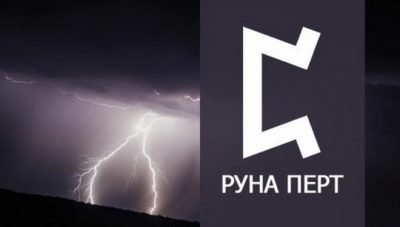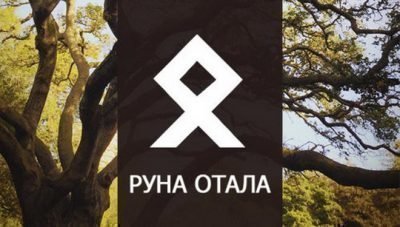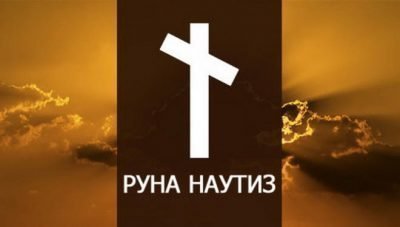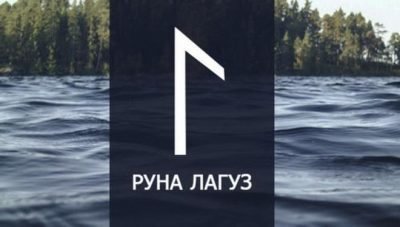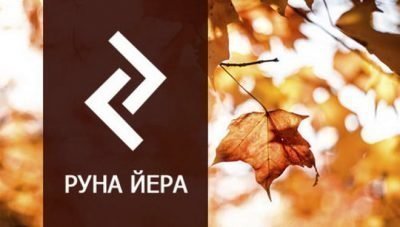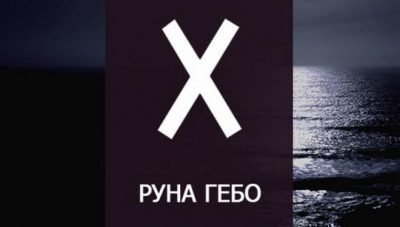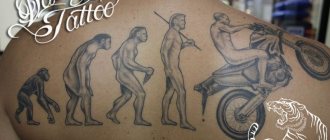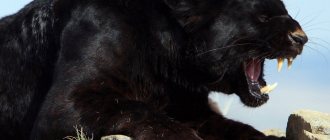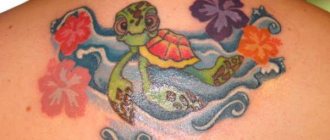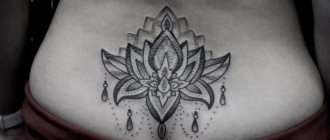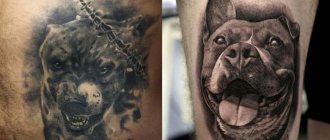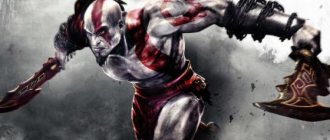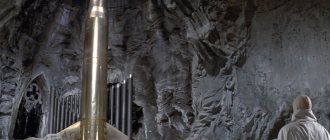Scandinavian ornaments in a man (photo)
Scandinavian runes are popular among fans of body art. What's appealing about them is the pattern. And regardless of what exactly is depicted in the Scandinavian style - runes, helmets, or even nature, such drawings attract the eye.
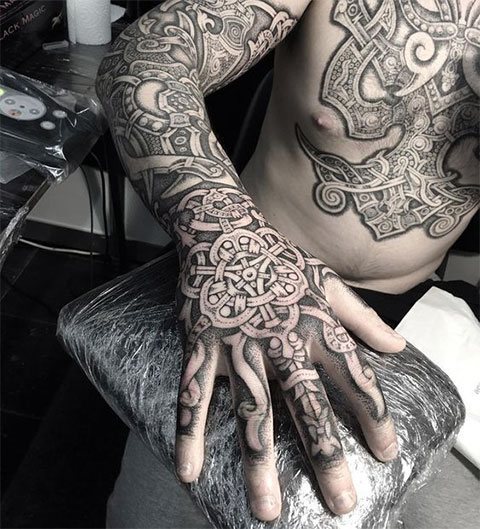
Scandinavian tattoos on the body (photo)
As you know, in Scandinavia lived Norwegians, Danes, Swedes and Icelanders. It is unknown if all the Norse had tattoos on their bodies. But as for the Vikings, who went to work at sea, they made themselves insignia in the form of tattoos. If the cinematography is to be believed, both the heads and faces of sea robbers and travelers were covered with tattoos. However, it is not known for certain, it is believed that the Vikings painted on the body paint, which after a while washed away.
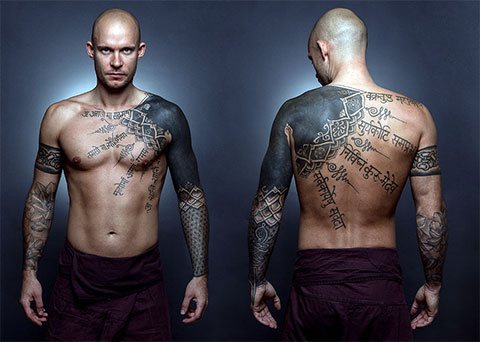

Photo of the Scandinavian tattoo
As the Scandinavians worshipped the three gods, tattoos had a magical meaning to them. Through drawings, warriors asked for blessings for battles and good luck in them. Scandinavian drawings were also made on weapons, considering them a talisman. No wonder that the Scandinavian body painting has reached our time.
Stylistics of Viking and Slavic tattoos
The fact that tattoos were popular even in BC is evidenced by various archaeological finds and historical written evidence. So, for example, tourists in the Alps was found by a mummy of a man on whose body the specialists found the traces of permanent image not erased over time.
The Ukok princess found in Russia, who lived many centuries ago, also has numerous pictures covering her body. There is also written evidence that the ancient Slavs and Vikings painted their bodies with special ritual drawings.
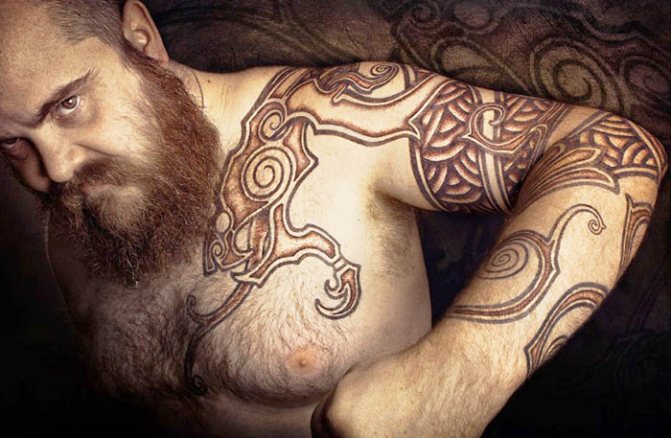

For example, Ibn Fadlan, an Arab traveler, in his book "Notes of a Journey to the Volga" reports that the bodies of fair-haired tall men were covered with pictures from fingers to shoulders and neck. Women of different ages also had amulets.
Tattoos of Vikings and Slavs are interesting with their symbols and their meanings. In addition to this pictures look stylish on the body of the carriers. What kind of images were caused by the ancestors of modern people on the body is not known. Historians suppose that they were runes, amulets, gods and animals.
The Scandinavian peoples were warlike and traveled a lot by sea on ships. They painted their faces, backs, arms and chests to scare off possible enemies and ill-wishers. The first Catholic priests noted that the Vikings were strong, long-haired men who covered their bodies with blue paint, which made them even scarier in battle.
The travelers spoke of the Slavs as light-haired farmers who could stand up for themselves if necessary. The bodies of the Russians were covered with pictures of ornaments, divine symbols and images of animals and plants.
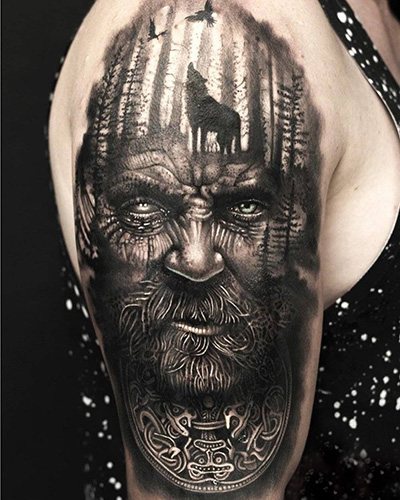

The Slavs and Vikings worshipped gods, and each of these peoples had its own pantheon. For example, the images of Odin, Thor or Freyja on the chest were very popular among men of the North. They also wore runes on their skin that helped them in battle and protected them from the magical influence of their enemies.
Despite the fact that representatives of these peoples lived in different parts of the European continent, historians find some similarities in their runes and other symbols. For example, both Russians and Vikings revered the bear and had a positive attitude toward owls, ravens and falcons.
The warriors put the image of the brown forest-dweller on their bodies for its strength and endurance. In addition, the bear was considered one of the hardest animals to defeat. Men put the image of the wolf on their skin so that the animal would endow them with the ability to track their prey well or to attack accurately.
Ancient people believed that birds painted on the body would help in guarding territory, hunting or traveling. In addition, some feathered representatives endowed the bearer of his image with wisdom or magical powers.
With a rune or a few symbols could be programmed person to victory, happiness or good luck. In the modern world, the sacred meaning of the ancient symbols has been lost, but some pictures are popular in the world today.
In the modern world, the sacred meaning of the ancient images has been lost, but some pictures are popular. To a greater extent men, and they are fans of the Scandinavians and Russians prefer to wear on the body patterns of symbols, images of the Vikings or mythical creatures, which can be learned from tales and legends.
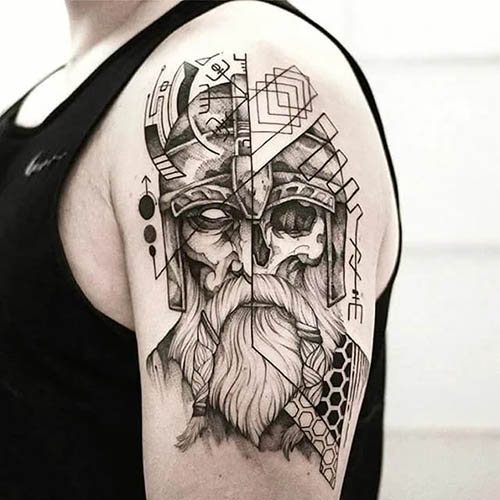

Experts note that Scandinavian or Slavic ornaments, applied to the human body, make him more masculine externally and stronger internally. In most cases, such pictures occupy a large part of the body and have monochrome colors. Bright drawings in the style of the Vikings or Slavs are rare.
Who are the Vikings?
Ancient Vikings were the inhabitants of Scandinavia (Sweden, Norway, and Denmark) who were sailors and warriors. They lived from the 8th to the late 11th century along the coasts of the North Sea and the Baltic Sea.
Although the Vikings are considered savage barbarians known for their raids, they were also good explorers, artists, artisans, farmers, and traders. They produced various goods such as honey, wax, and weapons and traded them for silver, silk, and precious metals.
They also had an orderly society based on laws, norms and democracy. God Odin and his son Thor were their most important persons. Currently, they are some of the most popular tattoo motifs.
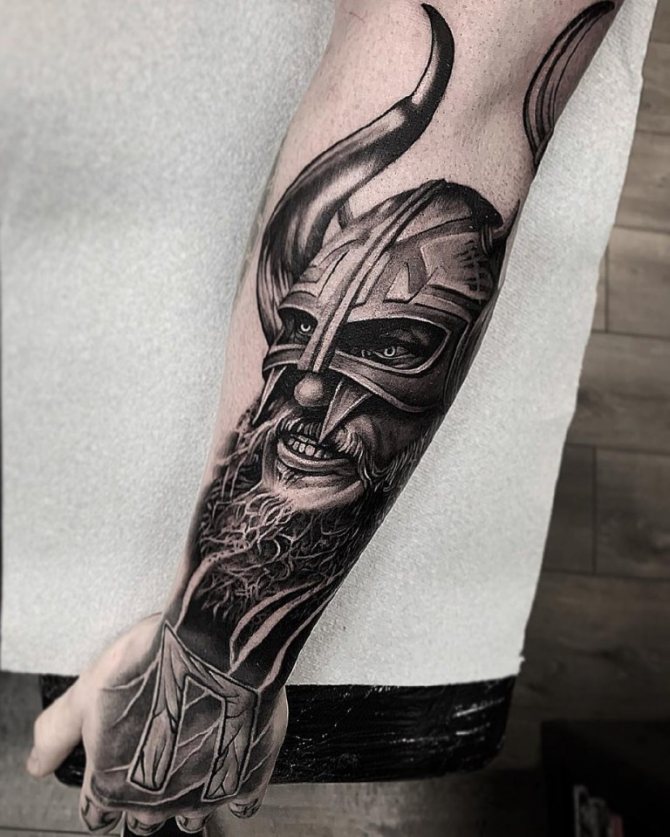

Who are suitable for Scandinavian and Slavic tattoos
Slavic and Viking tattoos are suitable for sturdy men who are 25+ years old. The tattoos were used by both Scandinavians and Russians to draw indelible images on the body only by a shaman or a sorcerer. In order to choose the right tattoo for a person, he was in a trance and consulted with the spirits.
Besides, personal images were applied only to people over 30 years old because it was considered that only at that age the full formation of physical and spiritual qualities of the person comes to an end. Ancestors believed that by getting a tattoo a person not only corrects his body, but also experiences reprogramming of the energy plans at subtle levels. For fun or just for decoration, it was prohibited to apply a tattoo on the skin.
Tattoos in the traditional styles of the Slavs and Vikings are suitable:
- Men who want to emphasize their strength and assertiveness.
- Fearless people.
- Travellers.
- Loyal to their cause and conviction.
- Guys who want to become stronger physically and mentally.
- Those who want to protect themselves from possible negative influences.
- Women who want to acquire the necessary qualities.
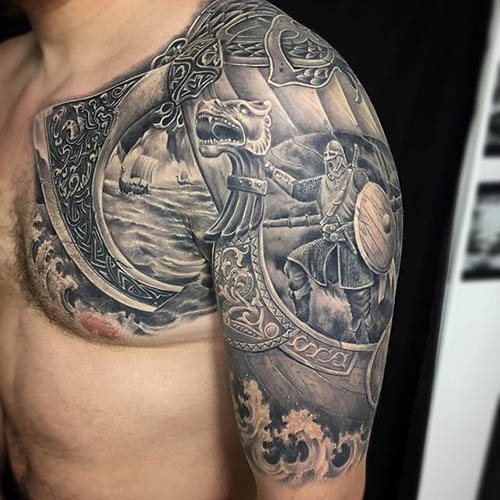

In addition, such permanent drawings allow you to reveal a person's inner potential and show yourself in the most unexpected skills. Also abstract patterns will allow you to hide defects and scars on the body.
Did the Vikings have tattoos?
The Vikings are believed to have decorated their bodies with tattoos to express their status and faith. The Arab traveler Ahmad ibn Fadlan, who was sent on a diplomatic mission to Bulgaria, where he met the Vikings, writes: "Every man has an axe, a sword and a knife, and carries them with him at all times. Everyone is tattooed from his fingernails to his neck...".
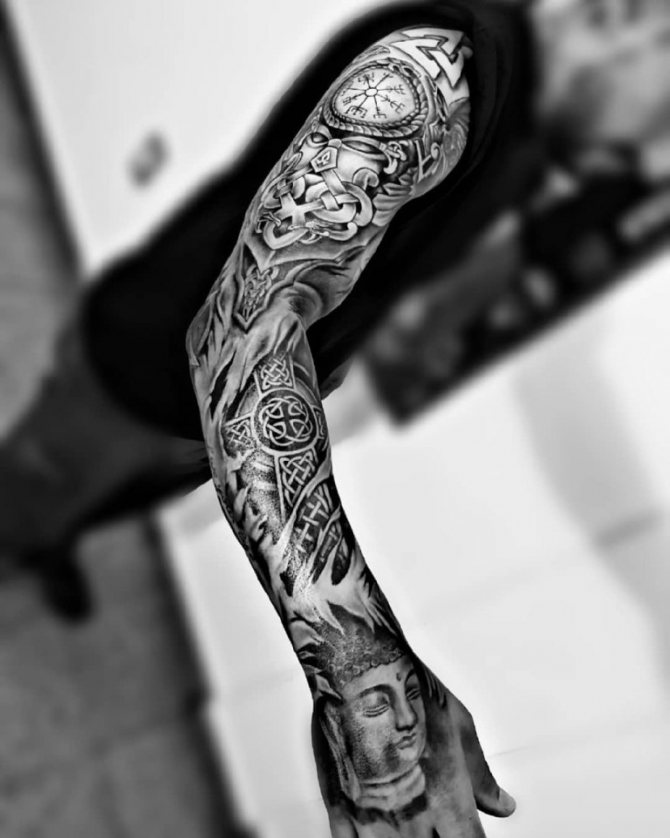

According to Ahmad's observations, the Vikings tattooed their fingers and other body parts, including their shoulders.
Who shouldn't get a tattoo
In addition to the positive aspects that carry Slavic and Viking tattoos, there are also negative aspects that a picture can convey to its owner. For example, if a mystical symbol, such as a rune, is portrayed incorrectly on the skin, then instead of helping in life, it will destroy it.
Specialists do not recommend doing a tattoo in the style of the Vikings or Russians to those who:
- Does not feel it.
- Doubts.
- Weak physically and mentally.
- Does not possess a strong will.
- Afraid of change in life.
- Housebound.
- Is withdrawn.
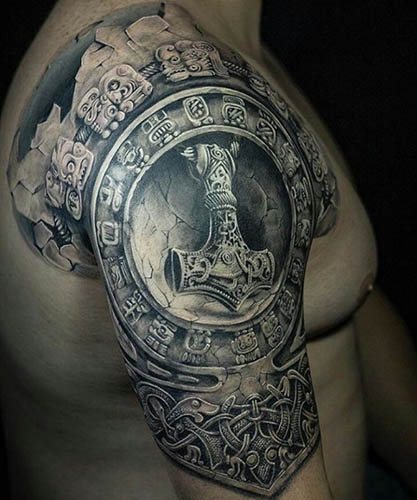

One of the important conditions for choosing a permanent picture is to feel it on one's own body. This is related not only to tactile sensations, but also to internal ones. If there is something suspicious or displeasing in the proposed sketch, it is better not to apply such a picture. Also, you should not paint a picture if there are doubts about whether it is necessary at all.
Specialists do not recommend making a tattoo with strong energy, for example, in the style of the Vikings or Slavs, on a physically weak body. In this case, it will not fill the owner with energy, but will take it away. In addition, the drawing will look bulky on the body of the wearer, which will be an additional discomfort.
Runic symbols of the northern or Slavic peoples are suitable for people with a strong will and character. If a person is weak and subject to extraneous influence, it is better not to make a picture, because it aggravate these qualities.
Northern runes or symbols Russians better not do if a person is afraid of change in life. Specialists have found that permanent marking affects the psychological state of the person, and he, after the procedure in the tattoo salon begins to change, which leads to changes in his surrounding life.
Not recommended to apply the Scandinavian or Slavic patterns on the skin of those who like to sit at homeAnd those who like to sit at home and do not communicate much. In this case, the picture will make a person even more withdrawn and unsociable.
Female Scandinavian Tattoos
Girls are especially eager to stuff themselves with a variety of runic patterns and amulets. It is worth noting that the Vikings women always fought on an equal footing with men. Female warriors bravely went into battle and raids. Modern women are very inspired by this tradition, equality and independence. That is why today to find a tattoo sketch girls often turn to the Scandinavian themes.
You may also find this article interesting: History and varieties of tribal tattoos
Suitable places on the body
Tattoos of the Vikings and Slavs usually take up a lot of space on the body, so they are applied to:
- arms;
- legs;
- breasts;
- abdomen;
- back.
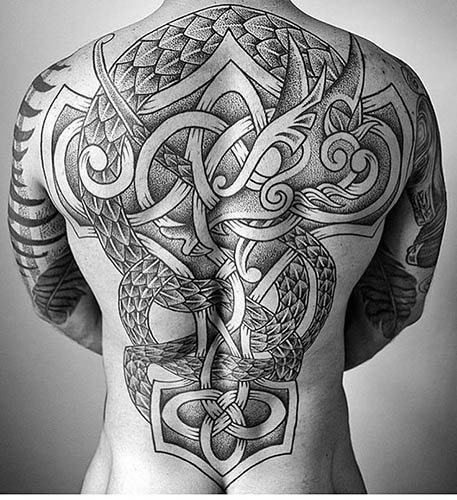

Most men order a "sleeve" in a tattoo shop with symbols of Russians or Scandinavians. In addition, pictures from the history of these peoples are popular. According to ancient tradition, tattoos should cover the human body like armor.
If there is no desire to make a volumetric large picture, you can order a separate runes or their ligature from the master.
In this case, the picture is placed on:
- wrist;
- The back of the hand;
- neck;
- shoulder blade.
To put a rune image on the legs, lower back, abdomen or buttocks esotericists do not recommend.
Men's Scandinavian Tattoos
Tattoos of the Scandinavian tradition have been particularly actively gaining popularity in recent years. Many men are close to the philosophy of courage, militancy and bravery of the Vikings. Images of brave warriors can be found in TV shows and movies, modern culture often refers to the Nordic mythology. For example, the legendary image of Ragnar Lothbrok from the TV series "Vikings" fell in love with the audience and inspired many men to exploits and new tattoos.
Stylistics of images, the choice of style
From the choice of the sketch depends and the style of tattooing on the body.
Scandinavian or Slavic patterns are made in the technique:
- "Dotwork".
- "Treble."
- "Blackwork."
- "Ornamental".
- "Etnika".
- "Pagan."
- "Celtic."
Picture in the style of "Dotwork" consists of a lot of individual dots, densely located on the selected area. Such tattoos take up a lot of space on the body.
Technique "Tribal" involves the use of black or gray colors. In this style they usually draw bold geometric lines, which under the experienced hand of the master turn into an individual ornament.
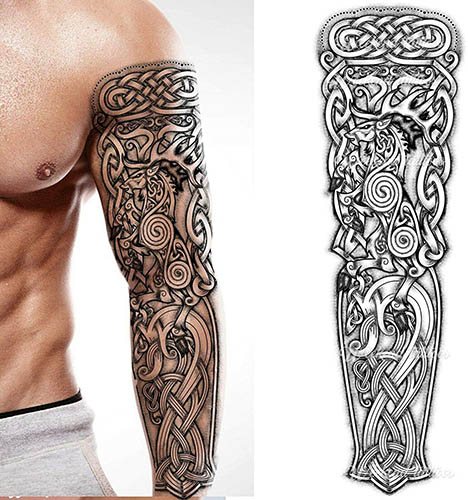

Suitable for the application of Scandinavian or Slavic tattoo technique "Blackwork", which in a foreign language means "black work". A picture in this style occupies a large area of the skin, and perform it only with black ink.
"Ornamental" is a style in which a selected ornament is applied to the client's body. The picture can be both in black and in color. Also folk motifs are applied and "Ethnic" and it is more peculiar to the Slavic drawings.
In most cases Slavic or Scandinavian tattoos are done in a pagan technique, the patterns are three-dimensional. For drawings are used ink of dark color. And for those who chose the symbolism of northern peoples, the Celtic style is suitable.
The emergence of the Scandinavian runes
Widespread tattoos have always remained runes. The Scandinavians believed that they inherited them from the gods. More specifically from the main deity Odin, who sacrificed himself for knowledge and chained himself to a tree, then pierced his body with a spear. Only a god could do such a thing. The god suffered nine days of pain, and then the runes were revealed to him, and Odin fell to the ground, scribbling on the tree with the pattern he had discovered, staining it with his blood. Thus appeared the alphabet of the ancient Norse, whose name became Futhark. In addition to writing, symbols denoted magical signs, as the Scandinavians believed.
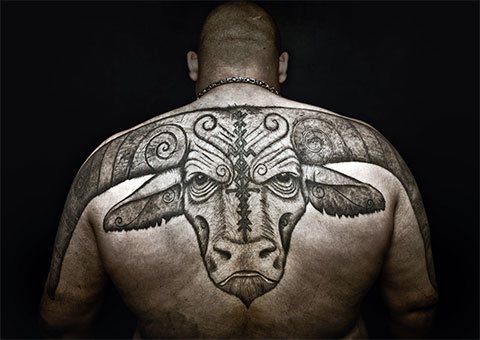

Photo of a Scandinavian tattoo on his back
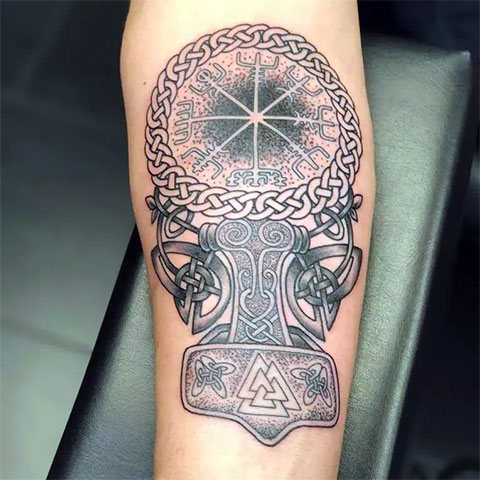

Photo of a Scandinavian tattoo
This legend went around Scandinavia, and people drew runes on their bodies, believing they were a gift from the gods. Tattoos do and with several runes, these drawings are more complex in execution, and are called galdrastavami, which from the Irish translates as "magic" and "sign".
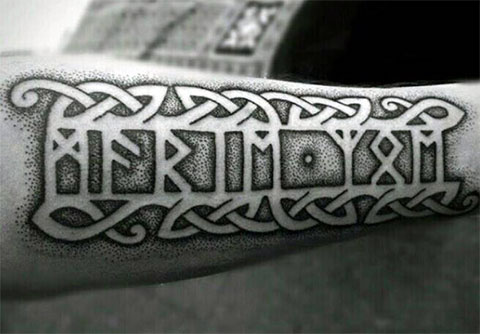

Scandinavian runes
Sketches and Meaning of Tattoos
Tattoos of the Vikings and Slavs have long had a sacred mystical meaning. Each pattern or picture endowed the wearer with the qualities inherent in it. For example, a boat or a ship on the Scandinavians' side gave a successful return home to a traveler, while a sword gave the wearer strength and confidence in a fight.
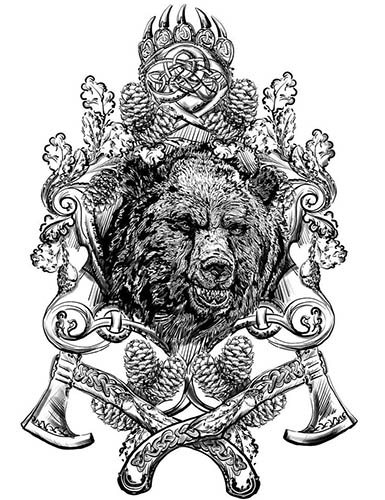

Among the images of the ancient peoples we can distinguish:
- abstraction;
- runes;
- symbols.
In addition, permanent drawings may contain mythical scenes from the life of the Vikings or Slavs.
Abstract patterns
When choosing a Scandinavian tattoo, you can ask for an abstract image. In this case the picture will have a hidden meaning, which will not always be understood by others. This technique involves applying geometric shapes and black and white or colored lines to the body.
In an abstract manner, you can depict an ancient tree, which will symbolize the connection with the genus and long life, or the rising sun, which gives energy to all life, including the owner of the tattoo. Often there are triangles, squares, circles or rectangles in such pictures, also having their own meaning.
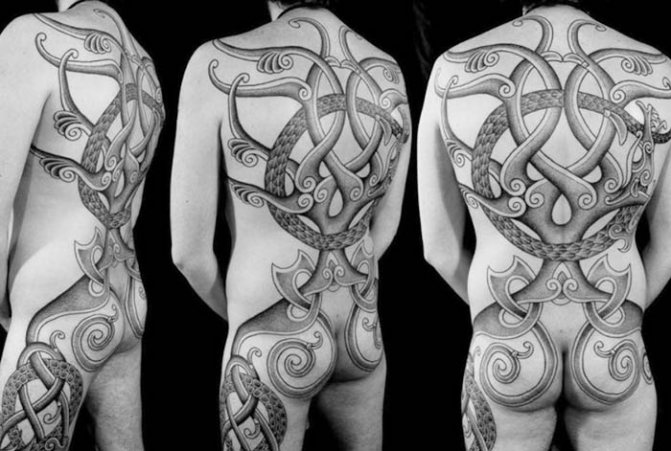

So, for example, if a triangle point is directed upwards, it indicates the masculinity of the owner of the picture, and if downwards - then on the femininity and sophistication. The square is a symbol of stability and the circle is a symbol of volatility and the ability to resolve any difficult situation. The rectangle is suitable for people who are good at getting their way and clearly define their goals.
Runes and symbols
It is impossible to imagine Viking and Slavic tattoos without runic symbols. Despite the external attractiveness of such signs, you need to know their symbolism and energy.
Ancient people endowed the runes with magical meaning and did not put them on the body just for fun. Properly written sign helped get rich or lucky to go hunting. In addition the runes could affect the weather, to save from a fire or flood.
The most popular Scandinavian and Slavic signs are:
- Fehu - wealth, good luck, uplift.
- Turisaz - awakens inspiration and the desire for order.
- Ansuz - helps to learn easily.
- Raido - helps to make the right decisions and choose the path of life.
- Nautiz - protects and gives endurance.
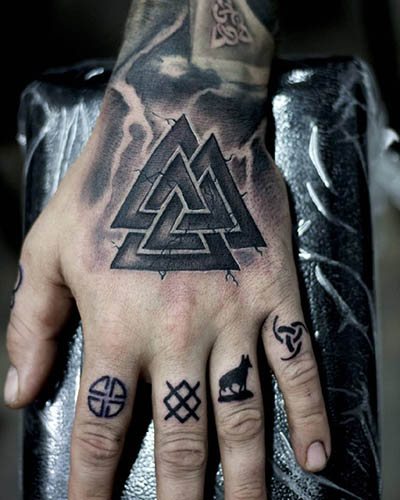

To the tattoo of the Vikings and the Slavs have different runes
In addition to individual runes on the body apply staves or knots of them. In this case, the image has several functions, and its meaning depends on the characters inscribed in it. Averting runes try to draw on a visible part of the body, and those that bring good luck - on the part of the skin, hidden from prying eyes.
Popular among fans of Slavic culture are traditional symbols:
- "Serpentine" - the symbol of the god Veles, helps to find the secret knowledge.
- "Gromovik" - symbol of the god Perun, protects from lightning and fires.
- "Ladinets" - symbol of the goddess Lada, helps to harmonize the inner and outer.
- "Solntsevorot" - symbol of the god Khors and the sun, gives energy.
- "Svorozhich" - amulet, symbol of the god Svarog.
Before applying any of the Slavic or Scandinavian signs on the body, you should know its meaning and choose a good specialist who will depict it without distortion. It is known that a wrongly drawn symbol changes its meaning to the opposite.
Big drawings of Viking warriors
The representatives of the stronger sex like to wear images of formidable Vikings on their bodies. Such pictures can be either black and white or in color and they also have their own meaning.
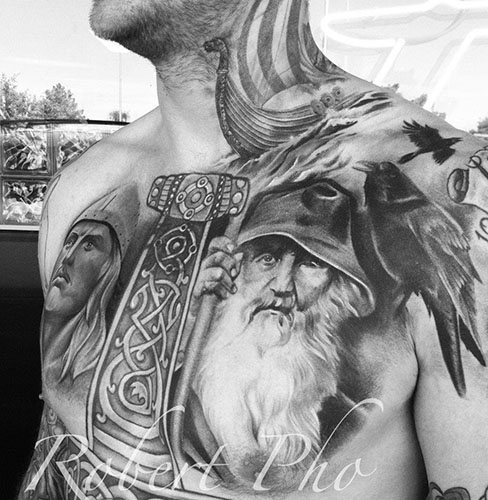

A Viking is the embodiment of strength, endurance, courage and independence. Choosing this image, men subconsciously want to emphasize these very qualities for others. In addition, the ancient warriors may have additional details, such as a sword or shield in their hands, a helmet on his head, a crow on his shoulder, or standing on the background of the ship. Such little things are also symbolic.
Vikings are usually depicted using techniques:
- "Blackwork.
- "Pagan."
- "Realism."
- "Oldschool."
Pictures are placed on the shoulders, back, arms or legs.
The meaning of the individual elements of the drawings
In addition to the main image, tattoos have more and details, which also carry a certain meaning and energy:
| The subject . | Meaning |
| helmet | Aspiration to victory, protection, courage |
| horns | fortitude, tenacity, superiority |
| sword | justice, struggle, strength |
| shield | fight with evil, protection, peace |
| raven | wind, longevity, secret knowledge |
| owl | wisdom, nobility, confidence |
| drakkar | Courage, strength, longing for travel. |
There are some images of gods on the tattoo. Owners of such pictures believe that tattoos with Odin or Thor will save them from life's troubles and surprises. Often on the helmet or shield of the Viking can be found runes or averting symbols of the Russians. In this case, the signs have several meanings and, in most cases, it is protection or luck.
Sometimes a large Viking tattoo depicts a snake or dragon. In this case, the mythical creature denotes loyalty, nobility and belief in supernatural forces.
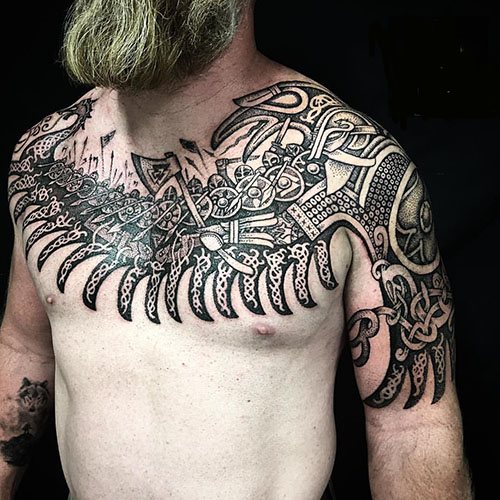

Waves, against which the ancient warrior stands on the tattoo symbolize strength, endurance and the desire for change. Such a supplement indicates that the owner of the picture is not afraid to move forward and does not like to stagnate in one place.
Tattoo of the Slavs and Vikings choose courageous guys. Such a picture emphasizes the beauty of the body and muscular relief. In addition, psychologists have found that men with such images are more often confident and attract the female sex.
Fenrir the wolf in mythology.
Was the second child of Loki and the giantess Angrboda. The huge wolf is the undoing of the gods and Odin. A notable character in Germanic and Scandinavian legends. The gods did not see him as a threat, so they allowed him to inhabit the expanses of Asgard. But over time, Fenrir became a very large and dangerous monster. No one wanted to approach him to feed him. However, Odin, the god of war, thunder and lightning, sometimes brought him food.
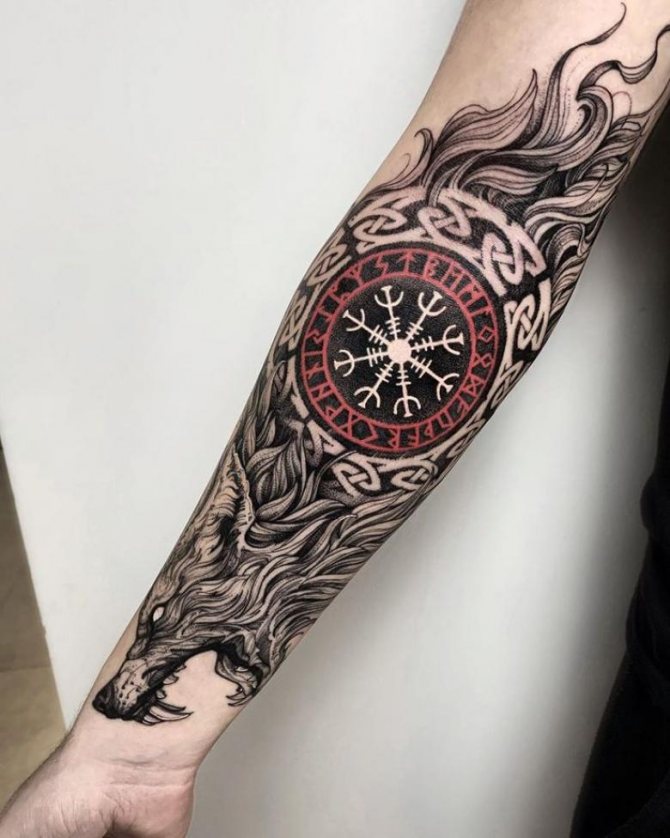

However, the Ases, the main gods of the Vikings were able to bind him with a special chain, the Gleipnir. It was made by dwarves from many mythical ingredients. It is believed that no one else would find a complete set of ingredients, as the last available pieces of material were used.
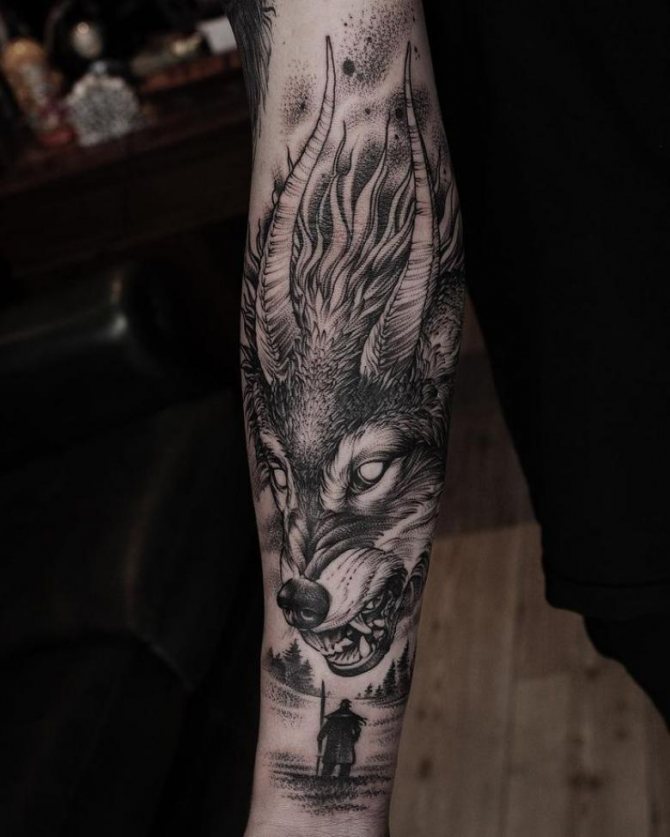

However, the god Thur had to put his own hand into Fenrir's huge mouth to demonstrate the safety of the chain. The wolf bit it off, but the Ases stuck the sword between the giant's jaws and kept it on a chain under the thick earth. So the Fenrir tattoo is associated with despair and a sign of hope for release from a difficult situation. But the story of Fenrir does not end there.
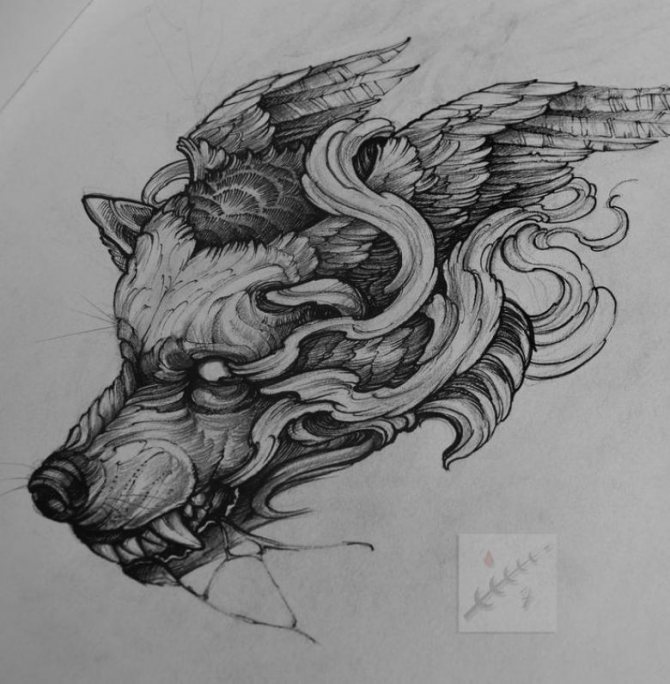

According to legend, Fenrir will be able to free himself to begin Ragnarok, the end of the world. Fenrir will kill the supreme god Odin. However, he would soon fall at the hands of Vidar, son of Odin, god of vengeance and silence. He was born of the union of Odin and the giantess Grid. However, this prophecy did not come true. The Aesir respected Fenrir, so they decided not to kill the wolf.


But in Celtic myths the wolf is not considered a sacred animal. However, Odin is killed by Loki. And Fenrir is mentioned rarely and is not considered an important character in mythology.


Application of the Teivaz rune in magic
The main magical action of the runes is to protect. It can protect from aggression and negative thoughts, to direct the right path and overcome obstacles, to unite the work team and prevent conflict situations.
Information: to help Teivaz resorted to when they want to win any tournament, heal from illnesses and improve health. The symbol helps women to win a man, but not with a curse, and men - to strengthen the male force, to win victories and fight bad habits.
In addition, Teivaz can help a man in the following matters:
- increasing attentiveness;
- overcoming obstacles;
- concentration on the work process;
- Strengthening of belief in one's strength;
- gaining dignity;
- an awareness of responsibility.
In ancient times, warriors believed that Teivaz would help them win, and on the eve of battle put this symbol on his body and on weapons.
Nowadays, the 17th rune is used by magicians very rarely. As a rule, turned to her when eliminating opponents or composition runescripts to work with masculine energy.
Inverted symbol Teivaz.
In divination often falls rune Teivaz in different positions: direct and inverted. Depending on this, the interpretation can change dramatically.
The appearance of the rune Teivaz in the straight position in the usual divination gives a person the ability to fight for their place under the sun. Such rune shows that within a person has a core that allows him to seek his position in any situation.
When the rune falls in a straight position, it can be interpreted differently.
- Rivalry in the team. This is a positive value, because a healthy competition in the workplace is only beneficial.
- Motivation - this can be any event that will stimulate a person to move forward.
- The person to whom Tivaz has fallen, always gets what he wants thanks to active, sometimes exhausting work.
- Willpower. A person can overcome obstacles, regardless of the temptations to stop and take a break. This description is strengthened together with the sign of Uruz.
If the interpretation is made to a person with a disease, the rune Teivaz may mean a speedy deliverance from the disease. It can be said that such a symbol falls when a person is moving towards the goal of his life.
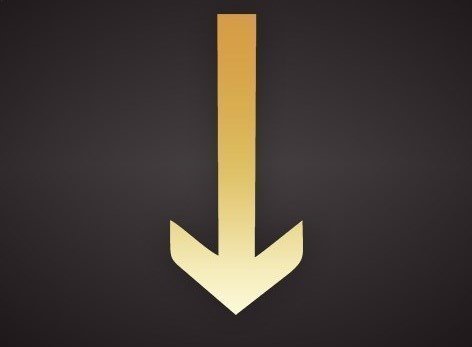

The meaning of the inverted Teiwaz rune is the end of a person's energy reserves. This does not mean that plans to implement will not succeed - in fact, more energy is needed.
If a man gets an inverted Teiwaz, it can be interpreted as the need to make a lot of profit with little effort. For a girl, Teiwaz has a similar meaning, but only if the neighboring letter is Laguz.
If inverted Teiwaz becomes the rune of the day, it means that the next day will be full of difficulties and worries, but do not despair - it will only strengthen the spirit and harden character. After a hard day awaits a reward - it may be a pleasant company of friends or meeting a loved one, but this can only be achieved by a lot of hard work.
If Teivaz in upside-down form comes to a person in a dream, it is an advice that it is worth thinking about plans for the future. It could mean that in the near future, a person will face a difficult challenge in his work.
Do not give up - victory comes only to those who fight for their happiness. If the letter Teivaz dreamed at a time when a person has a lot of problems in life - soon everything will be resolved very well.
In order to interpret the meaning of the rune Teivaz in more detail will help neighboring symbols in the layout.
|
|
|
|
|
|
|
|
|
|
|
|
|
|
|
|
|
|
|
|
|
|
|
|
Characteristics in divination
The meaning of this runic letter in witchcraft depends on the position in which it fell out. It is worth knowing, its appearance always speaks of the appearance in life of competitions and duels of any kind.
The direct position of Tur in divination predicts an increase in strength, authority, fighting spirit. The sign forbids passivity, obliging to get involved. It says that the near future is a period of action, accomplishment, and struggle.
When falling out Tiu, a person, making decisions, need to follow the moral principles, loyalty to the word, the honor. The sign warns that in the period of struggle people often overestimate their capabilities, so it calls for caution. However, it indicates that all problems can be solved and obstacles overcome.
If you fell inverted sign, then ahead - the difficulties in achieving the goal, the lack of momentum, connections, patronage. Interpretation Tiu in this position sometimes indicates illness or injury. The symbol speaks of the need to maintain moral principles. Predicting problems and troubles in the near future, the sign advises not to lose heart. It will take a little time, and the black belt will end, but live through this period, so as to preserve the honor.
What is the purpose of the amulet runoy Teivaz
Due to its powerful energetic essence, Teivaz is especially popular for creating amulets and talismans. Mainly runu used to achieve goals, the completion of projects and when combating addictions. The symbol ensures that all decisions taken were honest, legal and fair.


Teyvaz recommended to use only those who seek victory, regardless of the difficulties, and those who are actually requires considerable effort to obtain a reward.
Important: Teivaz gives courage, helps to overcome fears and get rid of anxiety. But, resorting to the help of amulet with Teivaz, a person should be aware that for his success, he will have to pay a considerable price.
Also, the amulet helps to strengthen your own influence and expand your power. Using the talisman for this purpose, it is necessary to remember: by granting protection and healing, Teiwaz develops the ability to kill, to break through defenses and to inflict crushing blows.
Layout for Love and Relationships
In the direct position, the description of the meaning of the Teivaz rune is as follows:
- Improved relationship between partners;
- high spiritual connection;
- Ideal physical compatibility.
The inverted rune Teivaz has the meaning of decreasing passion between two people in a relationship scenario. This is especially pronounced if the inverted rune falls with the sign of Isa. You can interpret this inverted symbol as a likely adultery if both runes have the opposite meaning.
If an inverted Teiwaz falls, its meaning for people who have just recently begun a relationship, it may mean the imminent end of a crush. Next, it depends only on the partners how communication will continue. Advice can be given to maintain a friendly relationship.
If the diagram made for a woman, Teivaz in inverted position means a speedy meeting with a new person, but the joy of such acquaintance will not bring. If there is a spark of passion between people, rather, it will extinguish because of a mismatch of views on everyday matters.
If the rune name Teivaz falls in a scenario with runoy Pert, it may indicate a weak spiritual connection between partners. This means that the relationship between people are based only on carnal love, where there is no place for higher matter.
Such a union can not exist for a long time. If the sign of Perth falls together with the rune Teiwaz in the inverted position, it may mean an imminent loss of interest in a partner.
Rune Teivaz in combination with the rune Eyvaz symbolizes problems in love. It may be the betrayal of a partner at the most difficult time in life. If the inverted rune, meaning warrior, combines in the layout with the sign of the Bercana, it could mean the restoration of the relationship after its termination. This is a good sign for partners who are divorced, quarreling or in a strained relationship.
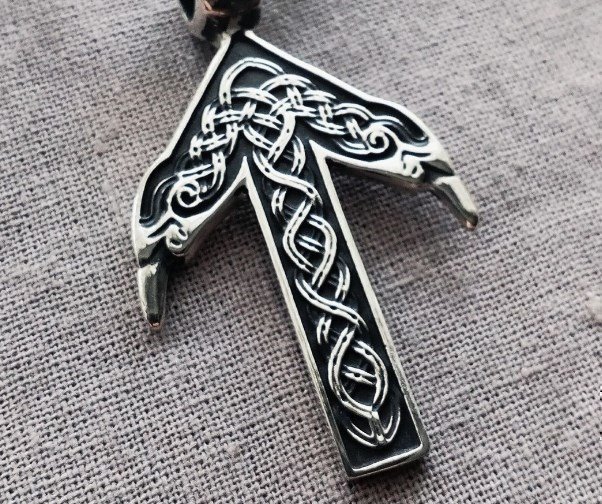

Together with Inguz, the inverted Teivaz signifies that a light streak will soon come to the relationship. Partners will be able to overcome difficulties on the way to a harmonious and happy relationship.
In love, the rune called Teiwaz advises to show perseverance and fortitude, even when the situation seems hopeless. In any problem there is always a way out, it only needs to be found. Remember that after a dark streak always comes a bright.
Questions to Meditate on the Teivaz Rune
Meditating on the Teivaz image is a great way to dive into the symbolic field of this magical rune. By meditating, one can get answers to questions such as:
- How do I need to work on myself for self-development?
- Am I aware of my inner strength?
- What do I need to do to overcome my own weaknesses?
- How strong is my spirit?
- Am I willing to take the path of the warrior without hesitation?
- Am I able to face my enemies, including my inner ones, with courage?
- What are my true fears?
- Am I willing to engage in mortal combat for the coveted victory?
- Am I using my true masculine qualities?
The Meaning of the Thur Rune
According to tradition, the symbol is also called Tyr or Tiu. Ancient warriors put it on their shields and uniforms. They believed that the sign concentrated the power of the god of war, giving protection and good luck.
The name of the rune comes from the name of Odin's adopted son. The warrior became famous when the Aesir needed to bind Fenrir, a monstrous wolf. The beast agreed to have a net thrown over it only if Thür put his hand in its mouth. The son of Odin knew what he would lose, but he agreed to Fenrir's offer. The wolf bit off the hand enclosed in its mouth, and Tür became the One-Handed God of War.
The sacred meaning of the epic is that a true warrior always makes the sacrifice voluntarily. We Scandinavians mark Tiu represents honor, courage, a voluntary sacrifice.
The power of the runes is based on service, self-denial, justice, as well as the priority of the spiritual over the material. It is important to know, rune Tyur requires firmness and fidelity to the ideals. However, will accept such a gift only from the man himself, and not from his environment.


